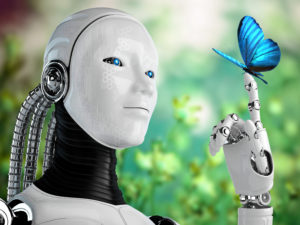Biomimicry and AI – Part 2
Angie Kellen, Director, Client Services, Open Sky Communications
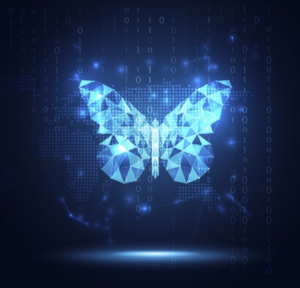 In my blog, Adopting Nature’s Wisdom – Biomimicry, I provided several examples of how humans have taken innovation inspired through nature and adopted it to our advantage. Humans have been using biomimicry to survive and problem solve for a long time. It makes sense to tap into 3.8 billion years of nature’s strategy to find answers to help ourselves. This helps set the stage for my follow-up blog, which is about biomimicry and artificial intelligence (AI). You may already know that we are using AI to speed up our implementation of biomimicry, but did you know we are using biomimicry to develop AI systems and tools? This blog will provide a high-level look at examples of ways in which biomimicry is being used to develop and improve AI systems. Let’s start with the most obvious biomimicry, humans.
In my blog, Adopting Nature’s Wisdom – Biomimicry, I provided several examples of how humans have taken innovation inspired through nature and adopted it to our advantage. Humans have been using biomimicry to survive and problem solve for a long time. It makes sense to tap into 3.8 billion years of nature’s strategy to find answers to help ourselves. This helps set the stage for my follow-up blog, which is about biomimicry and artificial intelligence (AI). You may already know that we are using AI to speed up our implementation of biomimicry, but did you know we are using biomimicry to develop AI systems and tools? This blog will provide a high-level look at examples of ways in which biomimicry is being used to develop and improve AI systems. Let’s start with the most obvious biomimicry, humans.
Humans, neural networks and AI
If you have followed artificial intelligence, you probably know that the computing network tries to mimic the neural network of our human brains. This is because our neural networks are very fast and efficient in the way that they recognize, process and store information. With AI requiring volumes upon volumes of data and complex algorithms, to be successful we need to constantly find ways to speed up the computing process, increase memory capabilities and storage as well as scale as needed. No small task for sure. A new study by McGill University (Montreal, Canada) has shown that AI networks designed using the human brain connectivity pattern performed cognitive tasks very efficiently. You may wonder why this is significant. After all, aren’t we modeling our AI architectures after human brains now?
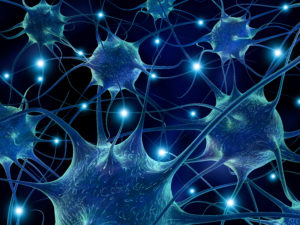 This is actually a unique approach in a couple of ways. Previous work on brain connectivity, known as connectomics, focused on identifying brain organization without looking at how it actually performs computations and functions. Also, traditional artificial neural networks have random structures that do not illustrate the way real brain networks are organized. The McGill University study integrated brain connectomics into the construction of artificial neural network architectures. Researchers were looking to both learn how the wiring of the brain supports specific cognitive skills and to discover innovative design principles for better AI. Neuroscience and AI have common roots, and by unifying the two disciplines they will help inform each other and enhance the understanding of the human brain. With these two scientific disciplines teaming up, they are already using greater efficiency to reach their respective goals.
This is actually a unique approach in a couple of ways. Previous work on brain connectivity, known as connectomics, focused on identifying brain organization without looking at how it actually performs computations and functions. Also, traditional artificial neural networks have random structures that do not illustrate the way real brain networks are organized. The McGill University study integrated brain connectomics into the construction of artificial neural network architectures. Researchers were looking to both learn how the wiring of the brain supports specific cognitive skills and to discover innovative design principles for better AI. Neuroscience and AI have common roots, and by unifying the two disciplines they will help inform each other and enhance the understanding of the human brain. With these two scientific disciplines teaming up, they are already using greater efficiency to reach their respective goals.
Bugs, DARPA and new architectures
Like many things, new discoveries are made in the quest to find technology that helps to keep nations safe from anyone that may wish to do them harm. One institution in the U.S. that provides this function is the Defense Advanced Research Projects Agency (DARPA), which has a research arm that is looking to nature to help design AI frameworks. A particular focus is on insects. DARPA plans to identify new computing paradigms that greatly improve learning times, as well as reduce computing power and the hardware needed for AI through biomimicry. But why insects? Very small flying insects have impressive computational capabilities! Who knew?
DARPA knows, and is focusing on small flying insects because they are the result of hundreds of years of evolutionary pressures that have required scale, size and energy reduction without the loss of performance. Small, efficient and capable of basic reasoning, these are the attributes DARPA has honed in on with respect to insects. Nature has demanded drastic miniaturization and energy efficiency, and has forced insect brains to evolve to where they can navigate the world around them with minimal information. When looking at the human brain, which contains up to 70 million interconnected neurons, trying to model it in terms of software is very difficult. In contrast, mapping insect brains that contain less than 1,000 neurons is a lot easier. This unique capability of problem solving with a brain of less than 1,000 neurons is of great interest as a platform that may help to simplify AI frameworks. DARPA believes that studying small insects will uncover innovations in architecture and computation that matches up to their simultaneous simplicity, efficiency, and complex functionality.
Slime molds, brains and the control center
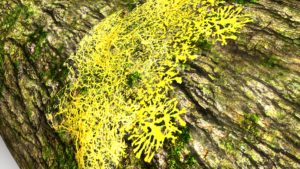 This was something new and surprising to me: first, that a slime mold is a living organism; and second, the fact that it does not have a brain. AI system designers can learn a lot from a slime mold’s incredibly complex system even though it looks like a spray of mustard. Its remarkability centers around memory retention and communication, even though it doesn’t have a brain or control center. Scientists are not completely sure how this mechanism works, but they think it might be related to the transfer of genetic information between slimes or even chemical communication. While this continues to be studied, slime mold offers a possible blueprint for designers to develop AI systems with the potential to be more efficient by experimenting with new strategies that don’t require a traditional control center. Also worth exploring and understanding is the slime mold’s mutual cooperation and swarm intelligence techniques. While we may think we have made great strides in understanding our world, this is a great example among many ideas in nature that can still surprise and inspire.
This was something new and surprising to me: first, that a slime mold is a living organism; and second, the fact that it does not have a brain. AI system designers can learn a lot from a slime mold’s incredibly complex system even though it looks like a spray of mustard. Its remarkability centers around memory retention and communication, even though it doesn’t have a brain or control center. Scientists are not completely sure how this mechanism works, but they think it might be related to the transfer of genetic information between slimes or even chemical communication. While this continues to be studied, slime mold offers a possible blueprint for designers to develop AI systems with the potential to be more efficient by experimenting with new strategies that don’t require a traditional control center. Also worth exploring and understanding is the slime mold’s mutual cooperation and swarm intelligence techniques. While we may think we have made great strides in understanding our world, this is a great example among many ideas in nature that can still surprise and inspire.
Cats, transistors and deep learning
Did you know that a cat’s brain is tremendously more efficient than our best computers? This may explain why cats have a superiority complex. Most of today’s computers use linear signaling, which means they communicate point to point. A cat’s brain operates differently. Geoffrey E. Hinton and his team determined that a cat’s brain processes sensory information in stages, one layer at a time, in specific parts of the brain. To mimic this process for computing, his team started writing algorithms that work in a similar way, one layer at a time and modeled on networks of neurons. The result of Hinton’s approach was a more efficient way to recognize speech and images, and it is the foundation used today by many big tech companies in Silicon Valley to conduct deep learning. Researchers continue to work on ways to replace the transistors that we use in computers with synapse-inspired devices called memristors that will more closely mimic a cat’s brain to provide quicker and more efficient computing for AI applications.
Spiders, webs and memory expansion
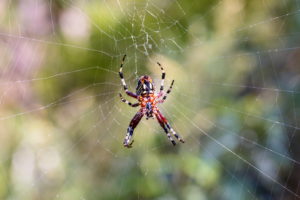 Spiders are truly amazing and mysterious, and I am happy to learn all I can from them, from a great distance. Most spiders have a brain about the size of a poppy seed and yet they not only construct complex insect traps, but also can expand their senses beyond the limits of their bodies. Spiders use their webs as a physical extension of their perceptual capabilities. Mostly nocturnal, Orb Weaver spiders are almost completely blind and are only able to see light, dark and a little movement. Researchers have concluded that there is a two-way connection between the web and the spider. Its behavior suggests that the web is a way for the spider to process information, allowing it to reserve precious brain power for other complex tasks like capturing prey. For more memory-intensive actions, like relocating prey in the web, they don’t need to remember every single thread they have spun. Instead, they only need to remember a few of their previous steps. Researchers believe that the Orb Weaver spiders use their webs as a form of extended cognition and that they outsource advanced mental tasks like problem-solving and memory. The way the Orb Weaver spider uses its web to sense its environment and expand its memory is being investigated as an innovative design for new AI systems to bring simplicity and greater efficiency to computing.
Spiders are truly amazing and mysterious, and I am happy to learn all I can from them, from a great distance. Most spiders have a brain about the size of a poppy seed and yet they not only construct complex insect traps, but also can expand their senses beyond the limits of their bodies. Spiders use their webs as a physical extension of their perceptual capabilities. Mostly nocturnal, Orb Weaver spiders are almost completely blind and are only able to see light, dark and a little movement. Researchers have concluded that there is a two-way connection between the web and the spider. Its behavior suggests that the web is a way for the spider to process information, allowing it to reserve precious brain power for other complex tasks like capturing prey. For more memory-intensive actions, like relocating prey in the web, they don’t need to remember every single thread they have spun. Instead, they only need to remember a few of their previous steps. Researchers believe that the Orb Weaver spiders use their webs as a form of extended cognition and that they outsource advanced mental tasks like problem-solving and memory. The way the Orb Weaver spider uses its web to sense its environment and expand its memory is being investigated as an innovative design for new AI systems to bring simplicity and greater efficiency to computing.
Ants, swarms and swarm intelligence
There is a lot to learn about optimization from these small picnic spoilers that can enhance AI systems. Collective intelligence occurs when a group of individual organisms, insects or animals work together with their environment to perform a common goal. In nature, this collaborative behavior is unique within each species. Ants put down pheromones directing each other to resources, bees use vibrations, fish feel tremors in the water, and birds sense motions spreading through the flock. Collective intelligence is the explanation for why ants colonize, bees swarm, fish school and birds flock. Nature has proven over and over that when individual creatures work and think together as a unified system toward a common goal, they have a high probability of reaching that goal faster and more accurately than if they were to attempt it individually.
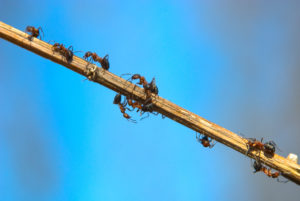 For example, individually ants may not appear to be very intelligent but they cooperate and work as a group to find solutions to problems, like finding the best route to the food source, or nearby picnic. Ants will wander around until one of them has found a source of food. The ant that found the food then leaves a trace of a chemical called pheromone while coming back to its group. The pheromone trace acts as a navigation tool for other roaming ants to use so they can reach the same food source. These ants also leave a trace of pheromone during their return. As a result, the pheromone trail becomes stronger and stronger with more ants using the same route to reach the food source and return. Eventually, all of the ants start following the same path to reach the food source. This is the result of collective intelligence.
For example, individually ants may not appear to be very intelligent but they cooperate and work as a group to find solutions to problems, like finding the best route to the food source, or nearby picnic. Ants will wander around until one of them has found a source of food. The ant that found the food then leaves a trace of a chemical called pheromone while coming back to its group. The pheromone trace acts as a navigation tool for other roaming ants to use so they can reach the same food source. These ants also leave a trace of pheromone during their return. As a result, the pheromone trail becomes stronger and stronger with more ants using the same route to reach the food source and return. Eventually, all of the ants start following the same path to reach the food source. This is the result of collective intelligence.
For AI, swarm intelligence is a group of optimization algorithms inspired by the way collective intelligence works. Swarm intelligence has many AI applications and there are many types of swarms that can be created. It provides the interfaces and AI algorithms to enable ‘human swarms’ to congregate online, combining the insights, wisdom, knowledge and intuitions of diverse groups into a single developing intelligence. From predicting marketing and sports trends to evaluating the effectiveness of movie trailers and advertisements, real-time swarms have been shown to significantly expand intelligence. Wikipedia is an example of a human swarm.
Swarm learning combines a special kind of information exchange across different nodes of a network using methods from the toolbox of ‘machine learning’. Machine learning is a subfield of AI that provides computers the ability to learn without being programmed. Machine learning algorithms are trained on data to detect patterns that consequently acquire the ability to recognize the learned patterns in other data as well. Swarm learning clears a path for new opportunities to collaborate in medical research, as well as in business and other areas. The important point to note is that all participants can learn from each other without having to share confidential data. This brings us full circle to swarm intelligence being based on the way collective intelligence works.
Conclusion
There are many great opportunities in AI that will intersect almost all aspects of our lives. And it is in understanding and imitating nature and leveraging its evolutionary power that enables increased performance and efficiency, along with scalability for AI systems. Nature is the teacher providing us with a framework to study. We are the students that must prepare for the future of AI development and put in place the infrastructure required to fashion data into transformational solutions. Both now and in the future, we can continue to find new discoveries that provide inspiration and unique solutions as there seems to be no limits to the solutions nature can show us. It’s in our best interest to open our eyes to the perfection found in nature.
